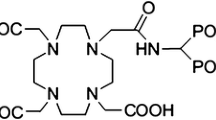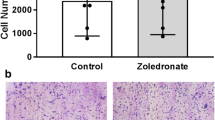Abstract
Purpose. To validate our hypothesis that a bisphosphonate (BP) having a nitrogen-containing heterocyclic ring on the side chain, and with no hydroxyl on the geminal carbon would possess increased activity, and better oral bioavailability due to enhanced solubility of its calcium complexes/salts and weaker Ca chelating properties.
Methods. A novel BP, 2-(2-aminopyrimidinio)ethylidene-l,l-bisphosphonic acid betaine (ISA-13-1) was synthesized. The physicochemical properties and permeability were studied in vitro. The effects on macrophages, bone resorption (young growing rat model), and tumor-induced osteolysis (Walker carcinosarcoma) were studied in comparison to clinically used BPs.
Results. The solubility of the Ca salt of ISA-13-1 was higher, and the log βCa: BP stability constant and the affinity to hydroxyapatite were lower than those of alendronate and pamidronate. ISA-13-1 exhibited effects similar to those of alendronate on bone volume, on bone osteolysis, and on macrophages, following delivery by liposomes. ISA-13-1 was shown to have 1.5−1.7 times better oral absorption than the other BPs with no deleterious effects on the tight junctions of intestinal tissue.
Conclusions. The similar potency to clinically used BPs, the increased oral absorption as well as the lack of effect on tissue tight junction of ISA-13-1 warrant its further consideration as a potential drug for bone diseases.
Similar content being viewed by others
REFERENCES
H. Fleisch. Bisphosphonates in bone disease: From the laboratory to the patient, The Parthenon Publishing Group, NY, 1997.
N. Makkonen, M. R. Hirvonen, T. Teravainen, K. Savolainen, and J. Monkkonen. Different effects of three bisphosphonates on nitric oxide production by RAW 264 macrophage-like cells in vitro. J. Pharmacol. Exp. Ther. 277:1097-1102 (1996).
G. A. Rodan. Mechanisms of action of bisphosphonates. Annu. Rev. Pharmacol. Toxicol. 38:375-388 (1998).
J. H. Lin. Bisphosphonates: A review of their pharmacokinetic properties. Bone 18:75-85 (1996).
P. C. D. Groen, et al. Esophagitis associated with the use of alendronate. New Engl. J. Med. 335:1016-1021 (1996).
J. H. Lin, I.-W. Chen, and F. A. Deluna. On the absorption of alendronate in rats. J. Pharm. Sci. 83:1741-1746 (1994).
I. M. Twiss, R. de Water, J. den Hartigh, R. Sparidans, W. Ramp-Koopmanschap, H. Brill, M. Wijdeveld, and P. Vermeij. Cytotoxic effects of Pamidronate on monolayers of human intestinal epithelial (Caco-2) cells and its epithelial transport. J. Pharm. Sci. 83:699-703 (1994).
W. K. Sietsema and F. H. Ebetino. Bisphophonates in development for metabolic bone disease. Exp. Opin. Invest. Drugs 3:1255-1276 (1994).
E. Van Beek, M. Hoekstra, M. Van de Ruit, C. W. G. M. Lowik, and S. E. Papapoulos. Structural requirements for bisphosphonate actions in vitro. J. Bone Miner. Res. 9:1875-1882 (1994).
J. M. Van Gelder and G. Golomb. The evaluation of bisphosphonates as potential drugs for the treatment of calcium-related disorders. In A. Ornoy (eds.), Animal models for human related calcium metabolic disorders, CRC Press, Boca Raton, 1995, pp. 181-205.
N. V. Mikhalin, I. S. Alferiev, I. L. Kotlyarevskii, and A. V. Krasnukhina. Method of preparation of higher 1-hydroxyalkylidene-1,1-diphosphonic acids or their mixtures or salts. Russian Patent SU 1,719,405. Chem. Abst. 117:234254x (1992).
I. S. Alferiev and N. V. Mikhalin. Reactions of vinylidenediphosphonic acid with nucleophiles, Commun. 5, Addition of heterocyclic amines and trimethylamine to vinylidenediphosphonic acid. Bull. Russ. Acad. Sci., Div. Chem. Sci. 44(8):1528-1530 (1995).
L. E. King and R. Vieth. Extraction and measurement of pamidronate from bone samples using automated pre-column derivatization, high-performance liquid chromatography and fluoresence detection. J. Chromatogr. 678:325-330 (1996).
H. Cohen, V. Solomon, I. S. Alferiev, E. Breuer, A. Ornoy, N. Patlas, N. Eidelman, G. Hagele, and G. Golomb. Bisphosphonates and tetracycline: Experimental models for their evaluation in calcium-related disorders. Pharm. Res. 15(4):606-613 (1998).
P. W. Swaan, G. J. Marks, F. M. Ryan, and P. L. Smith. Determination of transport rates for arginine and acetaminophen in rabbit intestinal tissues in vitro. Pharm. Res. 11:283-287 (1994).
S. P. Robins, A. Duncan, N. Wilson, and B. J. Evans. Standardization of pyridinium crosslinks, pyridinoline and deoxypyridinoline, for use as biochemical markers of collagen degradation. Clin. Chem. 42(10):1621-1626 (1996).
J. Mönkkönen, M. Taskinen, S. O. K. Auriola, and A. Urtti. Growth inhibition of macrophage-like and other cell types by liposome-encapsulated, calcium-bound, and free bisphosphonates in vitro. J. Drug Target 2:299-308 (1994).
F. E. Nargi and T. J. Yang. Optimization of L-M cell bioassay for quantitating tumor necrosis factor in serum and plasma. J. Immunol. Methods 159:81-91 (1993).
N. Pennanen, S. Lapinjoki, A. Palander, A. Urtti, and J. Monkkonen. Macrophage-like RAW 264 cell line and time-resolved fluoroimmunoassay (TRFIA) as tools in screening drug effects on cytokine secretion. Int. J. Immunopharmacol. 17:475-480 (1995).
N. Pennanen, S. Lapinjoki, A. Urtti, and J. Monkkonen. Effect of liposomal and free bisphosphonates on the IL-1β, IL-6 and TNFα secretion from RAW 264 cells in vitro. Pharm. Res. 12:916-922 (1995).
G. Golomb, A. Schlossman, H. Saadeh, M. Levi, J. M. Van Gelder, and E. Breuer. Bisacylphosphonates inhibit hydroxyapatite formation and dissolution in vitro and dystrophic calcification in vivo. Pharm. Res. 9:143-148 (1992).
R. J. Brown, E. van Beek, D. J. Watts, C. W. Lowik, and S. E. Papapoulos. Differential effects of aminosubstituted analogs of hydroxy bisphosphonates on the growth of Dictyostelium discoideum. J. Bone. Miner. Res. 13:253-258 (1998).
J. M. Van Gelder, E. Breuer, A. Ornoy, A. Schlossman, N. Patlas, and G. Golomb. Anticalcification and antiresorption effects of bisacylphosphonates. Bone 16:511-520 (1995).
M. D. Francis and R. G. G. Russell. Diphosphonates inhibit formation of calcium phosphate crystals in vitro and pathological calcification in vivo. Science 165:1264-1266 (1969).
J. R. Green, K. Muller, and K. A. Jaeggi. Preclinical pharmacology of CGP 42′446, a new, potent, heterocyclic bisphosphonate compound. J. Bone Miner. Res. 9:745-751 (1994).
C. D. Egger, R. C. Mühlbauer, R. Felix, P. D. Delmas, S. Marks, and H. Fleisch. Evaluation of urinary pyridinium crosslinks excretion as a marker of bone resorption in the rat. J. Bone Min. Res. 9:1211-1219 (1994).
D. H. Schweitzer, M. Oostendorp-van de Ruit, G. van der Pluijm, C. W. G. M. Lowik, and S. E. Papapoulos. Interleukin-6 and the acute phase response during treatment of patients with Paget's disease with the nitrogen-containing bisphosphonate dimethylam-inohydroxypropylidene bisphosphonate. J. Bone. Miner. Res. 10:956-962 (1995).
P. L. Nicklin, W. J. Irwin, I. F. Hassan, and M. Mackay. Development of a minimum calcium Caco-2 monolayer model: calcium and magnesium ions retard the transport of pamidronate. Int. J. Pharm. 123:187-197 (1995).
S. C. Sutton, K. Engle, and J. A. Fix. Intranasal delivery of the bisphosphonate alendronate in the rat and dog. Pharm. Res. 10:924-926 (1993).
X. Boulenc, E. Marti, H. Joyeux, Y. Roques, and G. Fabre. Importance of the paracellular pathway for the transport of a new bisphosphonate using the human Caco-2 monolayers model. Biochem. Pharmacol. 46:1591-1600 (1993).
E. J. van Hoogdalem, A. T. Wackwitz, A. G. de Boer, and D. D. Breimer. 3-Amino-1-hydroxypropylidene-1, 1-diphosphonate (APD): a novel enhancer of rectal cefoxitin absorption in rats. Pharm. Pharmacol. 41:339-341 (1989).
E. G. Lufkin, R. Argueta, M. D. Whitaker, A. L. Cameron, V. H. Wong, K. S. Egan, W. M. O'Fallon, and B. L. Riggs. Pamidronate: an unrecognized problem in gastrointestinal tolerability. Osteoporosis Int. 4:320-322 (1994).
F. Lanza, M. F. Rack, T. J. Simon, A. Lombardi, R. Reyes, and S. Suryawanshi. Effects of alendronate on gastric and duodenal mucosa. Am. J. Gastroenterol. 93:753-757 (1998).
J. Mönkkönen, H. M. Koponen, and P. Yalitalo. Comparison of the distribution of three bisphosphonates in mice. Pharmacol. Toxico. 65:294-298 (1989).
Author information
Authors and Affiliations
Corresponding author
Rights and permissions
About this article
Cite this article
Cohen, H., Alferiev, I.S., Mönkkönen, J. et al. Synthesis and Preclinical Pharmacology of 2-(2-Aminopyrimidinio) Ethylidene-1,1-Bisphosphonic Acid Betaine (ISA-13-1)-A Novel Bisphosphonate. Pharm Res 16, 1399–1406 (1999). https://doi.org/10.1023/A:1018951025493
Issue Date:
DOI: https://doi.org/10.1023/A:1018951025493




